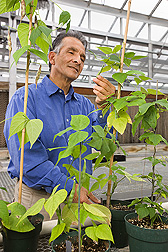This page has been archived and is being provided for reference purposes only. The page is no longer being updated, and therefore, links on the page may be invalid.
|
|
New Rust Resistance Genes Added to Common Beans
By Jan SuszkiwJune 4, 2010
New cultivars of common bean developed by Agricultural Research Service (ARS) scientists and their university colleagues could shore up the legume crop’s defenses against the fungal disease common bean rust.
According to Talo Pastor-Corrales, an Agricultural Research Service (ARS) plant pathologist in Beltsville, Md., the new cultivars possess two or more genes for resistance to the rust fungi. Most of the cultivars also harbor Ur-11, which is considered the most effective rust-resistance gene in the world.
Pastor-Corrales and his colleagues at the University of Nebraska and Colorado State University resorted to this multi-gene strategy in response to the high diversity of strains of the bean rust pathogen. Lately, virulent new races of rust that have overcome the Ur-3 resistance gene appeared in Michigan and North Dakota.
Until recently, this gene had been very effective in controlling rust in the United States, epecially in North Dakota and Michigan, the country’s largest bean-growing states. Now, Ur-3-protected varieties that once withstood the disease are succumbing to it, and there’s concern the new races will spread to other Northern Plains states where common beans are grown, such as Colorado and Nebraska.
Pastor-Corrales’ search for novel sources of rust resistance in dry-, snap- and other common beans has taken him to 21 countries in the Americas and 11 in Africa. The battle against rust is complicated by the fact that races present in crop fields can vary from one year to the next, adds Pastor-Corrales, who leads a bean breeding project at the ARS Soybean Genomics and Improvement Research Unit in Beltsville.
Read more about this research and similar efforts to protect other legume crops in the May/June 2010 issue of Agricultural Research magazine.
ARS is the principal intramural scientific research agency of the U.S. Department of Agriculture (USDA). This research supports the USDA priority of promoting international food security.

